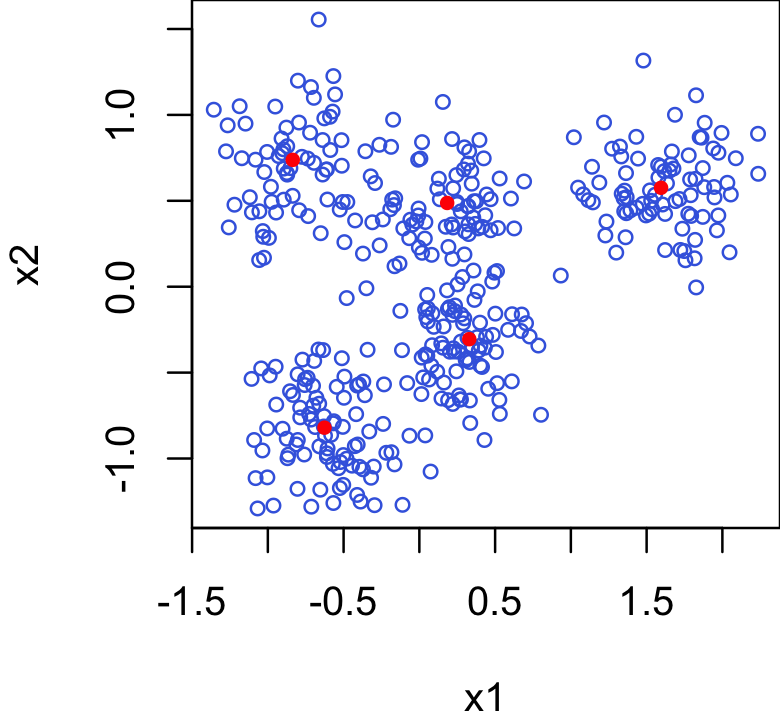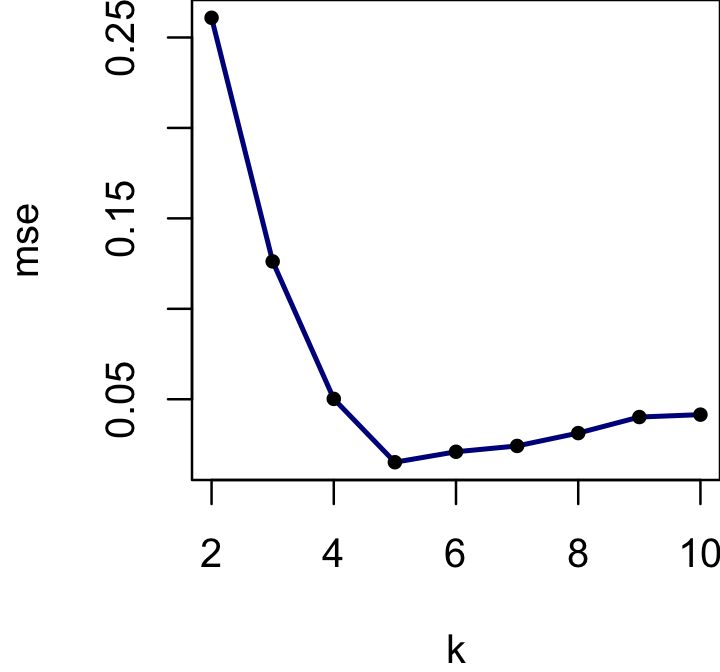k-means cross-validation demo
Peter Carbonetto
Last updated: 2022-12-08
Checks: 7 0
Knit directory: cv/analysis/
This reproducible R Markdown analysis was created with workflowr (version 1.7.0.3). The Checks tab describes the reproducibility checks that were applied when the results were created. The Past versions tab lists the development history.
Great! Since the R Markdown file has been committed to the Git repository, you know the exact version of the code that produced these results.
Great job! The global environment was empty. Objects defined in the global environment can affect the analysis in your R Markdown file in unknown ways. For reproduciblity it’s best to always run the code in an empty environment.
The command set.seed(1) was run prior to running the
code in the R Markdown file. Setting a seed ensures that any results
that rely on randomness, e.g. subsampling or permutations, are
reproducible.
Great job! Recording the operating system, R version, and package versions is critical for reproducibility.
Nice! There were no cached chunks for this analysis, so you can be confident that you successfully produced the results during this run.
Great job! Using relative paths to the files within your workflowr project makes it easier to run your code on other machines.
Great! You are using Git for version control. Tracking code development and connecting the code version to the results is critical for reproducibility.
The results in this page were generated with repository version 0cdce4b. See the Past versions tab to see a history of the changes made to the R Markdown and HTML files.
Note that you need to be careful to ensure that all relevant files for
the analysis have been committed to Git prior to generating the results
(you can use wflow_publish or
wflow_git_commit). workflowr only checks the R Markdown
file, but you know if there are other scripts or data files that it
depends on. Below is the status of the Git repository when the results
were generated:
Unstaged changes:
Modified: analysis/kmeans_demo.R
Note that any generated files, e.g. HTML, png, CSS, etc., are not included in this status report because it is ok for generated content to have uncommitted changes.
These are the previous versions of the repository in which changes were
made to the R Markdown (analysis/kmeans_demo.Rmd) and HTML
(docs/kmeans_demo.html) files. If you’ve configured a
remote Git repository (see ?wflow_git_remote), click on the
hyperlinks in the table below to view the files as they were in that
past version.
| File | Version | Author | Date | Message |
|---|---|---|---|---|
| Rmd | 0cdce4b | Peter Carbonetto | 2022-12-08 | workflowr::wflow_publish("kmeans_demo.Rmd", verbose = TRUE) |
| html | b6a0140 | Peter Carbonetto | 2022-12-08 | First build of the k-means demo. |
| Rmd | 1af11df | Peter Carbonetto | 2022-12-08 | workflowr::wflow_publish("kmeans_demo.Rmd", verbose = TRUE) |
This is another simple illustration of the perform_cv
cross-validation interface in which we use cross-validation to select
the \(k\) (the number of clusters) in
\(k\)-means. This example introduces
two slight complications that didn’t arise in the Elastic Net demo:
The \(k\)-means output depends on initialization. We address this by providing a common initialization for all the \(k\)-means runs. This ensures that
perform_cvalways produces the same result.The \(k\)-means problem is an unsupervised learning problem, so \(Y\) (which we define to be the unknown cluster centers) is not used in the “fit” function, and is only used for evaluating the quality of the fit.
Load the perform_cv code.
library(glmnet)
library(parallel)
source("../code/cv.R")Initialize the sequence of pseudorandom numbers.
set.seed(1)Simulate a clustering data set.
n <- 400
k <- 5
centers <- matrix(rnorm(2*k),k,2)
membership <- sample(k,n,replace = TRUE)
X <- matrix(0,n,2)
for (i in 1:n) {
j <- membership[i]
X[i,] <- centers[j,] + rnorm(2)/4
}
par(mar = c(4,4,0,0))
plot(X[,1],X[,2],col = "royalblue",pch = 1,cex = 0.75,xlab = "x1",ylab = "x2")
points(centers[,1],centers[,2],col = "red",pch = 20,cex = 1)
| Version | Author | Date |
|---|---|---|
| b6a0140 | Peter Carbonetto | 2022-12-08 |
The solid red points are the cluster centers.
Now run k-means once with \(k = 10\) clusters. We will use this to initialize the other runs of k-means.
fit_k10 <- kmeans(X,centers = 10,iter.max = 100)This function runs k-means, initializing the cluster centers using the k-means clustering result with \(k = 10\) clusters.
run_kmeans <- function (x, y, cvpar)
kmeans(x,fit_k10$centers[1:cvpar,],iter.max = 100)This function assigns the “best-fit” cluster centers to the data points.
predict_kmeans <- function (x, model) {
k <- nrow(model$centers)
D <- as.matrix(dist(rbind(model$centers,x)))
D <- D[1:k,-(1:k)]
i <- apply(D,2,which.min)
return(model$centers[i,])
}This function computes the mean squared error (MSE) between the estimated cluster centers and the true cluster centers.
compute_mse <- function (pred, true)
mean((pred - true)^2)Having defined these three functions, and determined a common
initialization for all the k-means runs, we are now ready to
use perform_cv.
k <- 2:10
cv <- perform_cv(run_kmeans,predict_kmeans,compute_mse,X,
centers[membership,],k)Now let’s see how the prediction error evolves as we change \(k\).
par(mar = c(4,4,0,0))
plot(k,rowMeans(cv),type = "l",col = "darkblue",lwd = 2,
xlab = "k",ylab = "mse")
points(k,rowMeans(cv),pch = 20)
Reassuringly, the lowest error is achieved at the correct number of clusters (\(k = 5\)).
sessionInfo()
# R version 3.6.2 (2019-12-12)
# Platform: x86_64-apple-darwin15.6.0 (64-bit)
# Running under: macOS Catalina 10.15.7
#
# Matrix products: default
# BLAS: /Library/Frameworks/R.framework/Versions/3.6/Resources/lib/libRblas.0.dylib
# LAPACK: /Library/Frameworks/R.framework/Versions/3.6/Resources/lib/libRlapack.dylib
#
# locale:
# [1] en_US.UTF-8/en_US.UTF-8/en_US.UTF-8/C/en_US.UTF-8/en_US.UTF-8
#
# attached base packages:
# [1] parallel stats graphics grDevices utils datasets methods
# [8] base
#
# other attached packages:
# [1] glmnet_4.0-2 Matrix_1.2-18
#
# loaded via a namespace (and not attached):
# [1] Rcpp_1.0.8 highr_0.8 pillar_1.6.2 compiler_3.6.2
# [5] bslib_0.3.1 later_1.0.0 jquerylib_0.1.4 git2r_0.29.0
# [9] workflowr_1.7.0.3 iterators_1.0.12 tools_3.6.2 digest_0.6.23
# [13] lattice_0.20-38 jsonlite_1.7.2 evaluate_0.14 lifecycle_1.0.0
# [17] tibble_3.1.3 pkgconfig_2.0.3 rlang_0.4.11 foreach_1.4.7
# [21] yaml_2.2.0 xfun_0.29 fastmap_1.1.0 stringr_1.4.0
# [25] knitr_1.37 fs_1.5.2 vctrs_0.3.8 sass_0.4.0
# [29] rprojroot_1.3-2 grid_3.6.2 glue_1.4.2 R6_2.4.1
# [33] fansi_0.4.0 survival_3.1-8 rmarkdown_2.11 magrittr_2.0.1
# [37] whisker_0.4 splines_3.6.2 codetools_0.2-16 backports_1.1.5
# [41] promises_1.1.0 ellipsis_0.3.2 htmltools_0.5.2 shape_1.4.4
# [45] httpuv_1.5.2 utf8_1.1.4 stringi_1.4.3 crayon_1.4.1